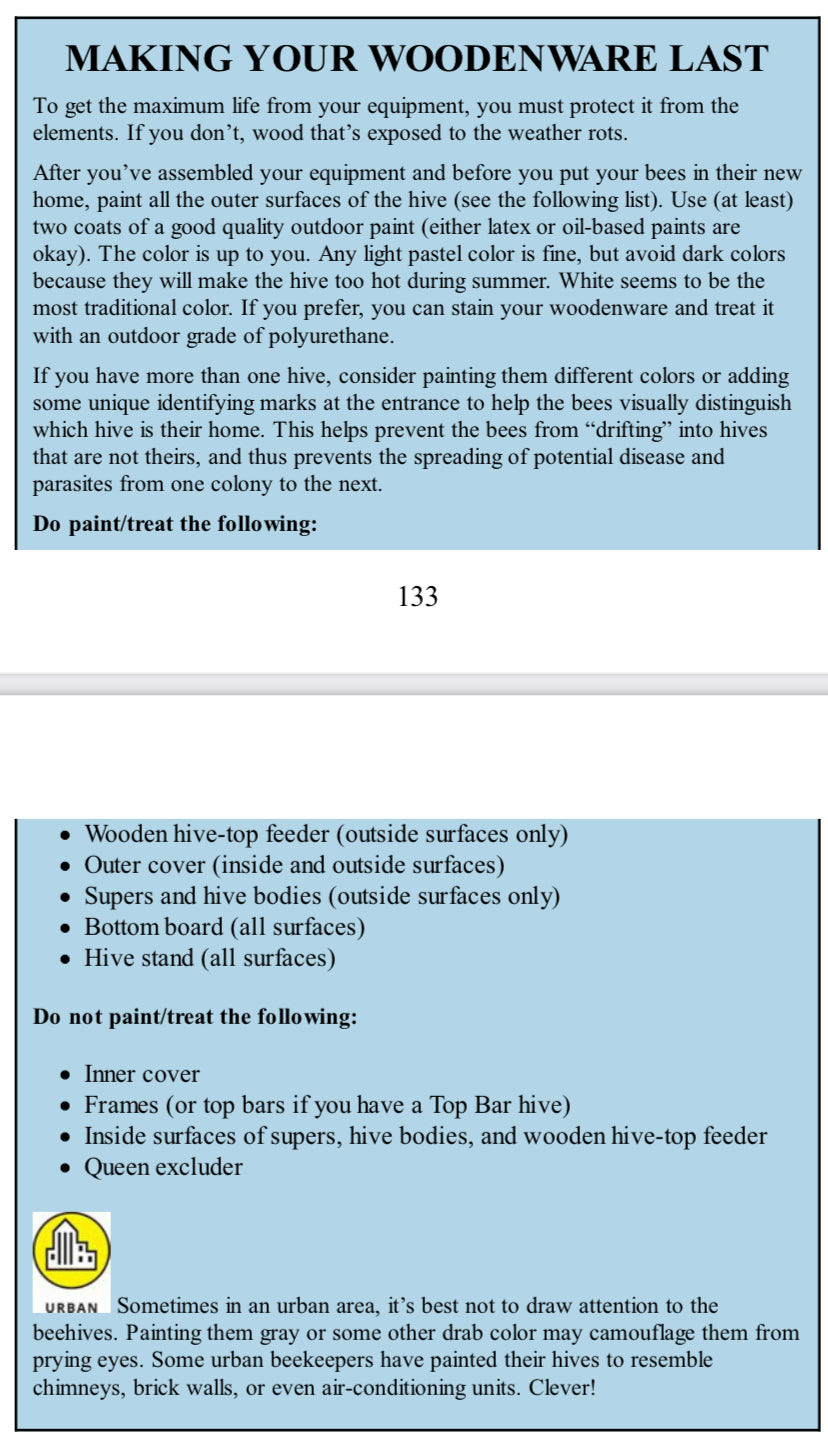Bees work hard making honey, so we need to provide them with a strong, comfortable home. Painting your beehives not only gives them a fresh look but also protects the wood and extends the life of your equipment. But where exactly should you paint, and what kind of paint is best? There's more to it than you might think!
Painting Your Beehives: Outside Only, Never Inside!
This is the golden rule of beehive painting:
-
Only Paint the Exterior: Your job is to protect the hive's "skin." This means you should paint all external surfaces of the hive, including the outside walls of the boxes, the top and sides of the outer cover, and the exterior of the bottom board.
-
Never Paint the Interior: Absolutely do not paint any part of the hive's interior! This includes the inside walls of the boxes, the frames, or the underside of the inner cover. Bees have their own "decorating" methods—they use propolis to seal gaps and maintain their internal environment. Artificial paint could emit harmful fumes, affect honey quality, or even harm the bees' health. Bees don't like painted interiors and might even refuse to build comb there!
Choose the Right Paint for a "Healthy" and "Long-Lived" Hive!
When picking paint for your beehive, the key factors are durability, safety for bees, and weather resistance.
-
Top Pick: Exterior Latex Paint (Water-Based) This is the preferred choice for most beekeepers.
-
Plenty of Perks: Water-based latex paint dries quickly, is easy to clean up (just use water for brushes!), and typically has lower Volatile Organic Compounds (VOCs), making it safer for both bees and you.
-
Primer is Crucial: No matter what topcoat you choose, always start with a good quality exterior wood primer. Primer seals the wood better, helps the topcoat adhere firmly, and provides an extra layer of protection against moisture and mildew.
-
Pick the Right Sheen: Opt for a semi-gloss or satin finish. These are generally easier to clean than a flat or matte finish.
-
-
Eco-Friendly Option: Low-VOC / Natural Paints If you're looking for a more natural, eco-conscious choice, there are paints specifically designed for beehives or children's toys that are low-VOC (or zero-VOC). These are usually water-based and often explicitly labeled "bee-safe" or "apiary-friendly."
-
Pure Tung Oil: If you prefer the natural look of wood and don't want a thick paint coating, pure tung oil is a good option. It soaks into the wood to provide protection. The downside is it might need more frequent reapplication (perhaps yearly), and in humid climates, an oil finish could be more prone to mildew.
-
-
Paints to Avoid:
-
Interior Paint: It's not designed for outdoor exposure and won't protect the wood.
-
Clear Varnishes or Polyurethane: Like the finishes you'd use on furniture. While they can look shiny, clear coatings usually don't block UV rays as effectively as opaque paints. UV light can degrade the wood underneath, causing the clear coat to crack and peel, which is a big hassle to refinish.
-
Strong, Lingering Odors: Avoid anything with a very strong, lingering chemical smell. This can be irritating or even harmful to bees.
-
Smart Beehive Painting Tips for a Perfect Finish!
-
Light Colors are Best: White is the most classic and practical color for beehives. It reflects most of the sunlight, helping to keep the hive cool during hot summers. Other light pastels like light blue, light green, or cream are also good choices.
-
Steer Clear of Dark Colors: Avoid using dark paints (like black, dark blue, or dark brown). Dark colors absorb a lot of solar heat, causing the hive to overheat. This can put significant stress on the colony and might even lead to the bees' demise, especially in warmer regions.
-
Allow for Full "Breathing" Time: After painting, place all hive components in a well-ventilated area and let them thoroughly dry and cure for several days to a week (oil-based paints might need even longer). Only when all volatile compounds have dissipated should you introduce bees to their new home.
-
Prep Work is Key: Before painting, clean any dirt or debris from the wood surface. For new, untreated wood, a light sanding can help the primer adhere better.
-
Multiple Coats for Better Protection: It's generally recommended to apply at least one coat of primer, followed by two coats of your chosen exterior paint, for the most complete and long-lasting protection.
By following these tips, your beehives will have a sturdy, attractive, and bee-friendly "new coat"! Ready to get started?
The content comes from ,《Beekeeping For Dummies》




